Design Of Experiment
Design Of Experiment. Eng. Ibrahim Kuhail. Introduction. Two fundamental approaches to problem solving problems in the discovery of knowledge: Theoretical (physical/mathematical modeling) Experimental measurement ( Most often a combination is used ). Introduction (Cont.).
Share Presentation
Embed Code
Link
Download Presentation
- factors
- factorial design
- nuisance factor
- factorial experiments
- basic factorial design
- 2 4 factorial design

sharonhall + Follow
Download Presentation
Design Of Experiment
An Image/Link below is provided (as is) to download presentation Download Policy: Content on the Website is provided to you AS IS for your information and personal use and may not be sold / licensed / shared on other websites without getting consent from its author. Content is provided to you AS IS for your information and personal use only. Download presentation by click this link. While downloading, if for some reason you are not able to download a presentation, the publisher may have deleted the file from their server. During download, if you can't get a presentation, the file might be deleted by the publisher.
Presentation Transcript
- Design Of Experiment Eng. Ibrahim Kuhail
- Introduction • Two fundamental approaches to problem solving problems in the discovery of knowledge: • Theoretical (physical/mathematical modeling) • Experimental measurement (Most often a combination is used) DOE Lecture 1
- Introduction(Cont.) Features of Alternative Methods • Theoretical Models • Simplifying assumptions needed • General results • Less facilities usually needed • Can start study immediately • Experimental approach • Study the “real world”-no simplifying assumptions needed • Results specific to apparatus studied • High accuracy measurements need complex instruments • Extensive lab facilities maybe needed • Time delays from building apparatus, debugging DOE Lecture 1
- Experimental Problems • Two aspects to any experimental problem: • DOE • Statistical analysis. DOE Lecture 1
- Design of Experiments • Design of Experiment (DoE): is a structured, organized method that is used to determine the relationship between the different factors (Xs) affecting a process and the output of that process (Y). • DOE is the process of planning the experiment so that appropriate data will be collected, resulting in valid and objective conclusions. DOE Lecture 1
- Design of Experiments (Cont.) • This method was first developed in the 1920s and 1930, by Sir Ronald A. Fisher, the renowned mathematician and geneticist. • DOE is used for: • Characterizing Processes. • Optimizing Processes. • Product Design. DOE Lecture 1
- Experiment • Test or series of tests where some changes are made to the input variables of a process or system. • Experimentation is very important in product design, manufacturing process, process improvements, and in developing a robust process. DOE Lecture 1
- Robust Process • A robust process is the process that is affected minimally by external source of variability. • The sensitivity of this process is high. DOE Lecture 1
- Objectives of Experiments • Determine which variables are most influential on the response Y. • Determine where to set the influential X’s, so that Y is almost near the nominal value. • Determine where to set the influential X’s, so that variability in Y is very small. • Determine where to set the influential X’s, so that the effect of the uncontrollable factors are minimized. DOE Lecture 1
- Process (System) • A process or a System is the combination of machines, methods, people, and other resources that transforms some input into an output that has one or more observable responses. DOE Lecture 1
- General model of a process (system) DOE Lecture 1
- Black Box • Within the black box; the following techniques may take place: • Personal opinion. • Scientific theory. • Trial and Error. • Experimentation. DOE Lecture 1
- Uncontrollable Factors • Uncontrollable Factors are factors that you can’t control them. You must minimize their effect on the response of the process. • Types of uncontrollable factors: • Input Factors. • Potential Input. • Key Input. DOE Lecture 1
- Strategies of Experimentation • Best-Guess Approach. In this approach, the level of one factor is switched for the next test based on the current outcome of the current test. Disadvantages: • Time consuming without any guarantee of success. • No guarantee on finding best solution. DOE Lecture 1
- Strategies of Experimentation (Cont.) • One Factor At A Time Approach: In this approach; a starting point for each factor is selected, then successively varying each factor over its range with the other factors held constant at the baseline. Disadvantages: • Time consuming. • It doesn’t take into account any possible interaction between the factors. DOE Lecture 1
- Interaction: Is the failure of the factor to produce the same effect on the response at different levels of other factor. DOE Lecture 1
- Strategies of Experimentation (Cont.) • Factorial Design: • Used when dealing with several factors. • Factors are varied together instead of one at a time. • Based on Fisher’s factorial concept DOE Lecture 1
- Types of factorial experiments • 22 factorial design: • 4 tests each is a corner of a square. • It may be done by replicating the design twice. • It enables the experimenters to investigate the individual effect of each factor. • It uses the data efficiently. DOE Lecture 1
- Types of factorial experiments (Cont.) • 23 factorial design: • There will be 8 tests, each is a corner of a cube. • 24 factorial design: • All the possible combinations of the levels of the factors are used. • Fractional Factorial Experiment: • Used when there are 5 or more factors. • it is a variation of the basic factorial design, in which only a subset of runs are made. DOE Lecture 1
- Types of Factorial Experiments (Cont.) • If there are K-factors, each of two levels; then the factorial design will require 2k runs DOE Lecture 1
- Basic Principles of Experimental Design • 3 Basic principle of DOE • Replication: repetition of the basic experiment • Obtain an estimation of exp. error. • Precise estimate of factor effect. But it is costly. • Randomization: the allocation of the experimental material and the order in which the individual runs of the experiment are randomly determined • By randomization; we averaging out the effect of extraneous factors that may be present. • Blocking: it is a technique used to improve the precision with which comparisons among the factors of interest are made. • Reduce or eliminate the variability of nuisance factors. DOE Lecture 1
- Nuisance Factors • Nuisance Factor: Is a factor that may affect the experiment response, but in which we are not directly interested. They can be divided into: • Controllable nuisance factor: a factor whose levels may be set by the experimenter. • Uncontrollable nuisance factor: it is uncontrollable, but it can be measured. Covariance analysis is used to control its effect. DOE Lecture 1
- Nuisance Factors (Cont.) • Noise factor: a factor that varies naturally and uncontrollably in the process and can be controlled for purposes of the experiment. • Each factor will have levels and a range • A block: Is a set of homogeneous experimental conditions. DOE Lecture 1
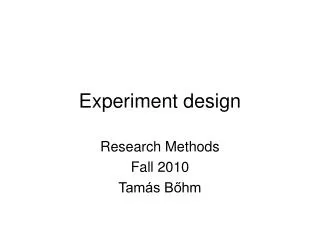
Experiment design
Experiment design. Research Methods Fall 2010 Tamás Bőhm. Elements of experiment design. Question Method Stimulus Control Interpretation. Question. Functional specialization of the cortex Development of functions (ontogenesis & phylogenesis) Operation of specific functions. Question.
408 views • 25 slides
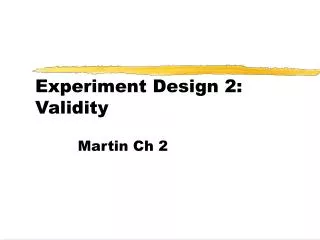
Experiment Design 2: Validity
Experiment Design 2: Validity. Martin Ch 2. Demonstration: how to design a bad experiment. How can we measure intelligence?. Conclusion validity. Statistical Appropriate statistics? Internal Really the cause? Construct (Measure) Measure what it is supposed to measure? External
302 views • 7 slides

Experiment Design of Experiment X Y
462 views • 22 slides
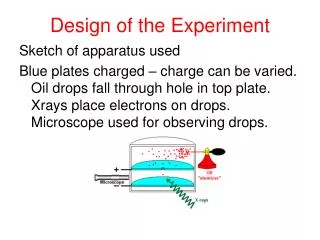
Design of the Experiment
Design of the Experiment. Sketch of apparatus used Blue plates charged – charge can be varied. Oil drops fall through hole in top plate. Xrays place electrons on drops. Microscope used for observing drops. Design of the Experiment. Photo of actual apparatus used in the experiments.
347 views • 13 slides

Design an Experiment
Design an Experiment . Like a Real Scientist. Let’s review what science is. This should do it. (7:30 – witches). And that elusive definition of a THEORY (7:30) http:// www.youtube.com/watch?v=9Re8QxKZdm0 And a LAW is what?. Research question .
472 views • 28 slides
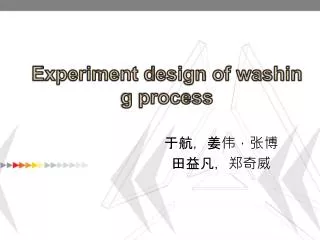
Experiment design of washing process
Experiment design of washing process. 于 航,姜伟,张博 田益 凡,郑奇威. Agenda. Motivation and object of the experiment Selection of factors Definition of response variable Design of experiment Analysis of experiment Conclusion Shortcomings and future extension. Motivation And Object .
333 views • 20 slides
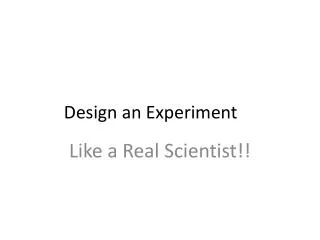
Design an Experiment
Design an Experiment . Like a Real Scientist. Let’s review what science is. This should do it. And that elusive definition of a THEORY http:// www.youtube.com/watch?v=9Re8QxKZdm0 And a LAW is what?. Research question .
624 views • 43 slides
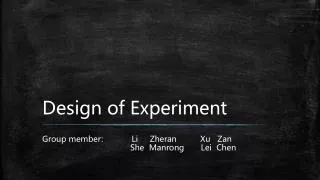
Design of Experiment
Design of Experiment. Group member: Li Zheran Xu Zan She Manrong Lei Chen. Content :. Motivation Literature review Design of Experiment Implementation Restrictions. Motivation .
539 views • 30 slides

Design experiment
Design experiment. Prepare libraries. Conduct sequencing. Produce FASTQ files. Pre- process data. No reference available. Assembly of genome sequence. R eference available. Map reads to reference genome or transcriptome. Assembly of transcriptome sequence. RNA transcripts.
356 views • 15 slides

Experiment design
Experiment design. Terrain height. WRF NUMBER OF TILES = 1 d01 2010-05-12_20:09:00 2 points exceeded cfl =2 in domain d01 at tim e 2010-05-12_20:09:00 hours d01 2010-05-12_20:09:00 MAX AT i,j,k : 188 3 3 ver
363 views • 10 slides
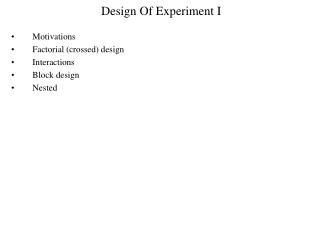
Design Of Experiment I
Design Of Experiment I. Motivations Factorial (crossed) design Interactions Block design Nested. Examples.
426 views • 21 slides

Experiment Design
Experiment Design. Suppose you want to do some experiments to improve a manufacturing process you think may be influenced by a dozen different factors What do you really want from the experiment – what does “optimal” mean? How can you most economically get the information you want?.
344 views • 22 slides

Design MANX experiment
Design MANX experiment. MANX magnet, Matching, and More. Katsuya Yonehara. Aim of the MANX experiment. MANX is a proof-of-principle experiment. Six dimensional helical cooling theory (ref. PRSTAB 8,041002 (2005)
385 views • 20 slides
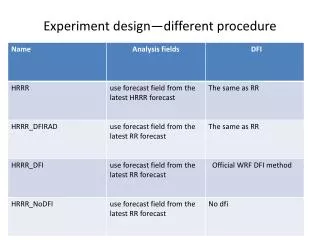
Experiment design—different procedure
Experiment design—different procedure. Experiment design—different procedure. Future Plan?.
165 views • 5 slides

Experiment Design:
Mesoscale Variability on The Eastern Brazilian Shelf through a Roms Nested Model L. F. Rezende a, b ; P. Silva a ; A. Peliz a ; J. Dubert a & M. Cirano c
138 views • 1 slides

TITLE OF LAB: Design an Experiment
Unit 1: Becoming Chemists/Thinking Like a Doc—Scientific Method. Lab 2. Aim : How do I design an experiment?. AGENDA. Do Now. Introduction. Mini-Lesson. Summary. Work Period. Exit Slip. TITLE OF LAB: Design an Experiment
370 views • 16 slides

Experiment Design
Experiment Design. SCIPP Teacher Workshop Mary Jo Nordyke August 2010. The Muons in Cosmic Rays. Muons are one of many particles discovered in studies of cosmic radiation [which are a part of the natural radiation on Earth]
299 views • 15 slides

Design of experiment for computer simulations
Design of experiment for computer simulations. Let X = (X 1 ,…,X p ) R p denote the vector of input values chosen for the computer program Each X j is continuously adjustable between a lower and an upper limit, or 0 and 1 after transformation
304 views • 16 slides

Introduction to Experiment Design
Introduction to Experiment Design. Shiv Kalyanaraman Rensselaer Polytechnic Institute shivkuma@ecse.rpi.edu http://www.ecse.rpi.edu/Homepages/shivkuma. Refs: Chap 16-17 of Raj Jain’s book. Adapted from Prof. Raj Jain’s slides. Why Experiment design?.
425 views • 32 slides

Design of experiment I
Design of experiment I. Motivations Factorial (crossed) design Interactions Block design Nested. Examples.
369 views • 20 slides

Design of experiment, application in biology 2012
Design of experiment, application in biology 2012. Petr Císař. Points of presentation. Motivation Design of experiment Introduction Main steps Advantages Application in biology Process Method Results. Motivation. Experiment is one of the basic method of human understanding
217 views • 20 slides























